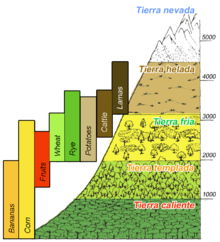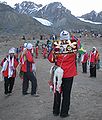Life zones of Peru
When the Spanish arrived, they divided Peru into three main regions: the coastal region (11.6% of Peru), that is bounded by the Pacific Ocean; the highlands (28.1% of Peru), that is located on the Andean Heights, and the jungle, that is located on the Amazonian Jungle (Climate of Peru). But Javier Pulgar Vidal (es), a geographer who studied the biogeographic reality of the Peruvian territory for a long time, proposed the creation of eight Natural Regions.[1][2] In 1941, he presented his thesis "Las Ocho Regiones Naturales del Perú" at the III General Assembly of the Pan-American Institute of Geography and History.

These eight Peruvian regions are:
- Chala or Coast (subtropical dry and tropical savanna)
- Yungas
- Fluvial Yunga
- Loma-Vegetation
- Quechua
- Suni or Jalca
- Puna
- Janca
- Rupa - Rupa or Highland Jungle
- Omagua or Lowland Jungle
Example: Andes 10°S
- See also Altitudinal zonation
Classic version, Amazonic side

- Sea level
- Estimated 22 - 24°C (75°F), but the cold Humboldt Current generates fog on the coast side
- Tierra caliente (Hot land, tropical) up to 2,500 ft (about 750 m - 1,000 m).
- Tierra templada (Temperate land, subtropical) up to 6,000 ft (about 1,850 m – 2,000 m)
- The warmest month has an average temperature of below 22°C or 72°F.
- Crops: Coffee, Tobacco, Maize, Coca, Peruvian Pepper (Schinus molle), Avocado, Guave (Psidium guajava), Cherimoya, Plum, Citrus fruits.
- Tierra fría (Cool land, temperate) below 12,000 ft (about 3,600 m, treeline)
- Tierra helada (Cold land) above 12,000 ft (about 3,600 m)
- Tierra Nevada (Janca), above the snow line, 15,000 ft (about 4,500 m - 5,000 m)
Javier Pulgar Vidal's version
The Peruvian geographer Javier Pulgar Vidal divided Peru in 8 regions (traditionally, it was costa, sierra and selva):
Map from República del Perú - Instituto Geográfico Nacional
- Chala (West, Pacific Coast) 0– 500 m
- Omagua (Lowland jungle or Selva baja, Amazonic rainforest) 80– 400 m
- Rupa-Rupa (Highland jungle, Selva alta) 400– 1,000 m
- Yungas (Aymaran for "Warm Lands", Cloud forest)
- Loma-Vegetation (West, "Yunga coastal" at the north of Peru) 450– 600 m
- Fluvial Yungas (East, "Yunga fluvial") 1,000- 2,300 m
- Quechua (East, High valleys) 2,300– 3,500 m
- Suni (or Jalca or Sallqa too, high plateaus and cliffs) 3,500– 4,100 m
- Puna (means "mountain top") 4,100– 4,800 m
- Janca (means white) above 4,800 m, permafrost, rocks, snow and ice[1]
Notes
- Biomes & Ecoregions nearby:[8]
Tropical and subtropical moist broadleaf forests
Montane grasslands and shrublands
Overview - Amazonic side
- Mouth of the Amazon River, Atlantic Ocean
- Belém, Brazil, 24 m, annual mean temperature 26.0°C
- Gurupa várzea (NT0126)[17]
- Manaus, Brazil, 72 m, annual mean temperature 26.6°C
- Monte Alegre várzea (NT0141)[18]
- Purus várzea (NT0156)[19]
- Colombia - Peru - Brazil border
- Leticia, Colombia, 84 m, annual mean temperature 25.8°C
- Tierra Caliente or Tropical rainforest
- Omagua or Selva baja (Southwest Amazon moist forests - NT0166)[11]
- Iquitos, Peru, 126 m, annual mean temperature 26.2°C
- Rupa-Rupa or Selva alta (Iquitos várzea - NT0128)[20]
- Yunga fluvial (more than 5°C colder than the Peruan Tropics)
- Peruvian Yungas (NT0153)[10]
- Quechua (High valleys, more than 10°C colder than the Peruan Tropics)
- Tree line
- Tierra Helada
- Suni (plateau)
- Tierra Helada
- Mountain pass
- Puna (mountain slope)
- Central Andean wet puna (NT1003)[21]
- Central Andean puna (NT1002)[13]
- "Andean-Alpine desert"
- Puna (mountain slope)
- Snow line
- Tierra Nevada or Janca
- Peak
Estimated temperatures - Continental Divide
Explanations:
- Region, elevation (m); avg annual precipitation (mm); avg annual temperature (°C);
- Peruvian Highland Rainforest (Tropical climate), Cloud forest (Subtropical climate) and Temperate forest (Temperate climate);
- Cusco reference, estimated avg annual temperature (°C, Lowland Rainforest or Selva baja gets more rain, so it is more cloudy, so it is cooler);
- Snow line reference, Humboldt cold current/ Pacific climate influence, estimated avg annual temperature (°C).[22]
| Elevation | West - Pacific side | East - Amazonian side | |
|---|---|---|---|
| Highland Rainforest or Selva alta | 400 m | - | 26.5 °C |
| Loma-Vegetation | 500 m | about 21.1 °C | - |
| Cloud forest or Fluvial Yunga | 1,000 m | - | 23.5 °C |
| Quechua - Montane Valleys | 2,300 m | - | 17.2 °C |
| Amazonian Tree line of Coniferae: 10 °C | about 3,500 m | - | about 10 °C |
| Mountain pass influence | 4,100 m | about 3.4 °C | (about 7.1 °C) |
| Vegetation end | about 4,800 m | about 0.0 °C | - |
| Snow line | about 5,000 m | about -1.0 °C | - |
Example: Kallawaya Region, Bolivia
Altitudinal zonation: Kallawaya Region, around Charazani, Bolivia (border to Peru).
- Glacier
- Elevation: 5,900- 5,200 m, Annual mean temperature: below 0 °C, Agriculture: none
- High Mountain Desert, Werneria ciliolata on scree
- Elevation: 5,200- 5,000 m, Annual mean temperature: below 0 °C - 0 °C, Agriculture: none.
- Grass Zone
- Calamagrostis minima Steppe,
- Elevation: 5,000- 4,600 m, Annual mean temperature: 0- 3.5 °C, Farming: alpacas, lamas.
- Pycnophyllum Steppe,
- Elevation: 4,600- 4,300 m, Annual mean temperature: 3.5- 7.5 °C, Farming: alpacas, lamas.
- Aciachne Humid Grassland,
- Calamagrostis minima Steppe,
- Shrub Zone
- Satureja Shrub (westslope), Baccharis pentandii Shrub, with Berberis (eastslope),
- Mutisia Shrub (westslope), Baccharis pentlandii Shrub, with Siphocampylus (eastslope),
- Kaunia longipetiolata Shrub,
- Elevation: 3,200- 2,700 m, Annual mean temperature: 13.5- 16.5 °C, Farming: cattle; Agriculture: maize, wheat, beans, spring potatoes, use of fertilizers, no crop rotation.
- Highland Rainforest,
Gallery
-
Costa - Sierra - Selva
-
Rupa-Rupa - High Rain forest
-
Mist forest (2,500 m)
-
Mountain slope (4,000 m)
-
Lake Quñuqqucha (4,050 m)
-
Puna with shrubs
-
Region of Ayacucho, Peru, 1986 - Puna
-
Region of Ayacucho, Peru, 1986 - Puna
-
Quyllur Rit'i, glacier and alpine desert - 2007
Text is available under the CC BY-SA 4.0 license; additional terms may apply.
Images, videos and audio are available under their respective licenses.
















